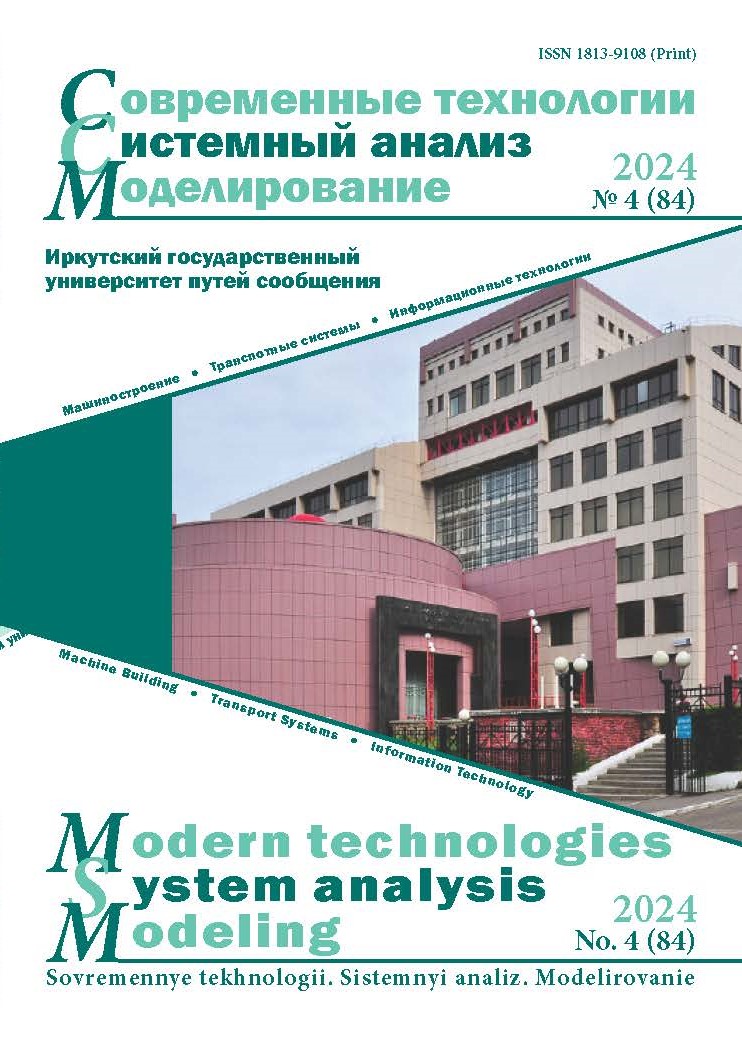Using a digital twin of an enterprise to assess the production performance of a transport organization
Keywords:
digital twin of an enterprise, transport organization, maintenance and repair of transport facilities, mean time between failures, failure rate, transport managementAbstract
Mass operation of any type of transport requires significant capital investments and financial costs for the maintenance and repair of the equipment in use. To obtain optimal production indicators of a transport organization, it is necessary to manage production assets and specialists involved in operation. Currently, such problems are solved intuitively, based on the previous experience of managers. Therefore, the task of implementing a scientific approach to the management of transport organizations is quite relevant. This paper presents the results of searching for an optimal variant of the service and repair group workload of a transport organization. A digital twin of an enterprise is proposed as a tool for solving this and other management problems of a transport organization. The analysis of the subject area showed that at the moment it is not possible to obtain such results by any other research methods, except for a digital twin of an enterprise. The initial data for constructing a digital twin of an enterprise are the results of product reliability tests and work timing. The use of a digital twin of an enterprise made it possible to perform a number of studies of the production indicators of a hypothetical transport organization and, in particular, to search for an optimal variant of the service and repair group workload of a transport organization. However, the capabilities of a digital twin of an enterprise are far from exhausted. The model, when entering the appropriate initial data, allows to solve a number of production problems that go far beyond the scope of this work. The digital twin of the enterprise presented in the work can be used not only in production, but also in studying a number of technical disciplines of the bachelor's, specialist and master's degrees such as «Reliability in Engineering», «Technical Diagnostics», «Organization of Transportation and Management in Transport» (Railway Transport). In addition, the digital twin of the enterprise can be used as a simulator for training and retraining the management personnel.
References
Кашковский В.В. Исследование законов функционирования систем технической эксплуатации промышленных и транспортных объектов. Saarbrucken: Lambert Academic Publishing, 2012. 312 с.
Солнышкина И.В. Теория систем массового обслуживания. Комсомольск-на-Амуре : КнАГТУ, 2015. 76 с.
Клейнрок Л. Теория массового обслуживания. М. : Машиностроение, 1979. 432 с.
Бочаров П.П., Печинкин А.В. Теория массового обслуживания. М. : РУДН, 1995. 528 c.
Беляев Ю.К. Массового обслуживания теория // Большая российская энциклопедия : сайт. URL : https://old.bigenc.ru/mathematics/text/2191088 (Дата обращения 30.08.2024).
Боровков А.А. Асимптотические методы в теории массового обслуживания. М. : Наука, 1980. 381 с.
Ивченко Г.И., Каштанов В.А., Коваленко И.Н. Теория массового обслуживания. М. : Высшая школа, 1982. 256 с.
Гнеденко Б.В., Коваленко И.Н. Введение в теорию массового обслуживания. М. : Наука, 1987. 336 с.
Новиков О.А., Петухов С.И. Прикладные вопросы теории массового обслуживания. М. : Советское радио, 1969. 399 с.
Лабскер Л.Г., Бабешко Л.О. Теория массового обслуживания в экономической сфере. М. : Банки и биржи ; ЮНИТИ, 1998. 318 с.
Хинчин А.Я. Работы по математической теории массового обслуживания. М. : Физматгиз, 1963. 236 с.
Чернецкий В.И. Математическое моделирование стохастических систем. Петрозаводск : ПГУ, 1994. 485 с.
Handbuch der Bedienungstheorie II : Formeln und andere Ergebnisse / K. Arndt, U. Arndt, G.P. Bascharin u.a. Berlin : Akademie-Verlag, 1984. 608 s.
Борисевич А.В., Дякин Н.В. Полумарковская модель для оценки показателей надежности источника бесперебойного питания дата-центра // Современные научные исследования и инновации. 2015. № 8-1 (52). С. 23–27.
Зеленый О.В., Носовский А.В., Стадник О.А. Полумарковские модели в задачах оценки надежности и риска от эксплуатации АЭС // Проблеми безпеки атомних електростанцій та Чорнобиля. 2007. № 7. С. 30–40.
Королюк В.С., Турбин А.Ф. Полумарковские процессы и их приложения. Киев : Наук. думка, 1976. 184 с.
Королюк В.С., Турбин А.Ф. Процессы Марковского восстановления в задачах надежности систем. Киев : Наук. думка, 1982. 235 с.
Полумарковские модели восстанавливаемых систем и систем массового обслуживания / А.Н. Корлат, В.Н. Кузнецов, М.М. Новиков и др. Кишинев : Штиинца, 1991. 275 с.
Козлов Б.А., Ушаков И.А. Справочник по расчету надежности аппаратуры радиоэлектроники и автоматики. М. : Советское радио, 1975. 471 с.
Копп В.Я., Обжерин Ю.Е., Песчанский А.И. Стохастические модели автоматизированных производственных систем с временным резервированием. Севастополь : СевГТУ, 2000. 286 с.
Ахмедов Г.М., Асланов Д.Г. Применение полумарковских моделей восстанавливаемых систем для расчета основных показателей надежности электровозов переменного тока // Universum: технические науки. 2018. № 3 (48). С. 72–77.
Grabski F. Applications of semi-Markov processes in reliability // Reliability: Theory & Applications. 2007. Vol. 2. № 3-4 (7). P. 66–75.
Grabski F. Semi-Markov failure rates processes // Applied Mathematics and Computation. 2011. Vol. 217. Iss. 24. P. 9956–9965. DOI:10.1016/j.amc.2011.04.055.
Limnios N., Oprisan G. Semi-Markov Processes and Reliability. Boston : Birkhauser, 2001. 225 p. DOI: 10.1007/978-1-4612-0161-8.


